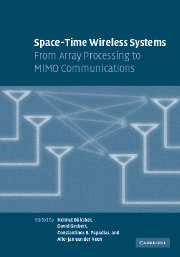Book contents
- Frontmatter
- Contents
- List of contributors
- Acknowledgments
- Introduction
- Part I Multiantenna basics
- Part II Space-time modulation and coding
- 7 Introduction to space-time codes
- 8 Perspectives on the diversity-multiplexing trade-off in MIMO systems
- 9 Linear precoding for MIMO channels
- 10 Space-time coding for noncoherent channels
- 11 Space-time coding for time- and frequency-selective MIMO channels
- Part III Receiver algorithms and parameter estimation
- Part IV System-level issues of multiantenna systems
- Part V Implementations, measurements, prototypes, and standards
- Index
7 - Introduction to space-time codes
Published online by Cambridge University Press: 25 February 2010
- Frontmatter
- Contents
- List of contributors
- Acknowledgments
- Introduction
- Part I Multiantenna basics
- Part II Space-time modulation and coding
- 7 Introduction to space-time codes
- 8 Perspectives on the diversity-multiplexing trade-off in MIMO systems
- 9 Linear precoding for MIMO channels
- 10 Space-time coding for noncoherent channels
- 11 Space-time coding for time- and frequency-selective MIMO channels
- Part III Receiver algorithms and parameter estimation
- Part IV System-level issues of multiantenna systems
- Part V Implementations, measurements, prototypes, and standards
- Index
Summary
Introduction
Information-theoretic analysis by Foschini (1996) and by Telatar (1999) shows that multiple antennas at the transmitter and receiver enable very high rate wireless communication. Space-time codes, introduced by Tarokh et al. (1998), improve the reliability of communication over fading channels by correlating signals across different transmit antennas. Design criteria developed for the high-SNR regime in Tarokh et al. (1998) and Guey et al. (1999) are presented in Section 7.3 from the perspective of typical error events (following the exposition by Tse and Viswanath (2005)). Techniques for multiple access and broadcast communication are described very briefly in Sections 7.9 and 7.10, where algebraic structure enables simple implementation. The emphasis throughout is on low cost, low complexity mobile receivers.
Section 7.2 provides a description of set partitioning, which was developed by Ungerboeck (1982) as the basis of code design for the additive white Gaussian noise (AWGN) channel. The importance of set partitioning to code design for the AWGN channel is that it provides a lower bound on squared Euclidean distance between signals that depends only on the binary sum of signal labels. Section 7.9 describes the importance of set partitioning to code design for wireless channels, where it provides a mechanism for translating constraints in the binary domain into lower bounds on diversity protection in the complex domain.
Section 7.4 describes space-time trellis codes, starting from simple delay diversity, and then using intuition about the product distance to realize additional coding gain.
- Type
- Chapter
- Information
- Space-Time Wireless SystemsFrom Array Processing to MIMO Communications, pp. 133 - 153Publisher: Cambridge University PressPrint publication year: 2006
- 1
- Cited by



